No products in the cart.
Quiet Hiring as a New Talent Acquisition Strategy
Unveiling the nuances of quiet hiring, this article provides an in-depth look at how this emerging strategy is revolutionizing talent acquisition and employee development, offering a fresh perspective on workforce management.
What is Quiet Hiring?
The concept of “quiet hiring” has emerged as a buzzword in the corporate world, especially in the wake of phenomena like “quiet quitting” and “quiet firing.” Quiet hiring refers to the practice where employers address talent gaps by shifting existing employees around or hiring contractors and part-time workers. This trend, though not entirely new, has gained prominence as organizations navigate through talent shortages and anticipate economic downturns.
The Driving Force Behind Quiet Hiring
Emily Rose McRae, senior director of research at Gartner, highlights that the primary reason for the adoption of quiet hiring is the acute talent shortage in the market. In some cases, the desired talent is simply not available, or the hiring process is so prolonged that it impacts business operations. Jennifer Kraszewski, SHRM-SCP, from Paycom, points out that the practice of upskilling current employees for new roles or focus areas, whether temporary or permanent, is not a new strategy but has become increasingly relevant in today’s dynamic business environment.
The Current Labor Market Climate
The relevance of quiet hiring is accentuated by the current labor market climate, characterized by a surplus of open jobs, reduced hiring budgets, and heightened turnover. McRae notes that high turnover rates are expected to remain consistently higher than pre-pandemic levels, necessitating the maximization of existing talent within organizations.

Reimagining Workforce Strategies
Jeff Schwartz from Gloat, a talent marketplace, and internal mobility platform, states that quiet hiring presents an opportunity to move beyond static job roles and standard recruiting practices. This approach aligns with the emerging skills-based hiring trend, acknowledging that the potential of current employees extends beyond their existing job descriptions. Brian Ferguson, a talent acquisition leader and founder of The Talent Trailblazer, asserts that quiet hiring is crucial in times of economic pressure, especially when traditional recruitment options are constrained due to labor shortages. By redistributing tasks among current staff, businesses can meet their essential requirements without overcommitting resources to new hires.
Forms of Quiet Hiring
Quiet hiring can be categorized into two forms: internal and external. External quiet hiring involves the hiring of short-term contractors, while the internal practice is more creative, encompassing short-term redeployment, internal mobility programs, rotational programs, and project or gig work. McRae gives an example of how HR and marketing data analysts can be shifted to cover data science roles, demonstrating practical implementation of quiet hiring.
Real-world Examples
One notable real-world example of quiet hiring is Australian airline Qantas asking employees, including managers and senior executives, to work as baggage handlers to address a labor shortage. Such instances highlight the flexibility and adaptability of quiet hiring in response to immediate business needs.
Quiet Hiring: A Boon for Professional Development
Quiet hiring is not just a strategy for businesses to fill talent gaps; it also offers significant opportunities for employee professional development. Temporary assignments can enable employees to acquire new skills and experiences, potentially leading to long-term career advancement. By engaging in different roles and exploring new areas of interest, employees can find renewed motivation and satisfaction in their work. Ferguson emphasizes that the success of quiet hiring in fostering employee development hinges on how employers articulate the value of these assignments and their role in advancing careers.
Addressing Quiet Quitting Through Quiet Hiring
Quiet hiring can also be seen as a strategic response to the phenomenon of quiet quitting, where employees disengage due to a lack of interest in their work. Kraszewski notes that quiet hiring offers employees the chance to explore new opportunities, possibly in different departments or teams. This shift can reinvigorate their enthusiasm for work, moving them away from unfulfilling tasks and towards assignments that present new challenges and learning opportunities.
Potential Risks and Downsides
While the benefits of quiet hiring are evident, it is also crucial to recognize its potential risks. Kraszewski warns of skills and knowledge gaps that may arise when individuals or teams pursue new opportunities. The transition to new roles, even if internal, requires time for training and adjustment. This process can create temporary inefficiencies and may impact business operations in the short term.
Challenges in Role Transition
McRae advises that employees transitioning to new roles, even temporarily, cannot be expected to keep up with all their previous role’s responsibilities. This necessitates a strategic decision to prioritize certain business areas over others. The transition process must be carefully managed to prevent resentment among employees who are chosen to move and those who are not. Moreover, setting realistic expectations is vital to avoid setting employees up for failure in roles for which they are not suited. For example, expecting customer service reps to retrain in data science within a short period is unrealistic. Instead, focusing on skill adjacencies and feasible role redesign is more practical.
Avoiding Equity and Inclusion Pitfalls
Another critical aspect to consider is the impact of quiet hiring on diversity, equity, and inclusion within the organization. Shifting talent around can inadvertently exacerbate existing issues around equity and access to opportunities. McRae suggests that organizations should be mindful not to limit opportunities to shift roles based on criteria like college degrees but rather focus on employees’ skills. Additionally, compensation adjustments for taking on more or less desirable tasks should be a part of quiet hiring decisions. This could be in the form of monetary compensation, more paid time off, or increased flexibility.
Effective Communication in Quiet Hiring
The success of quiet hiring significantly depends on how it is communicated to employees. McRae emphasizes that the messaging should not imply interchangeability but rather convey that employees are valued and being placed where they can have the most significant impact on the business. This approach can help ensure employee buy-in and reduce the potential for dissatisfaction.
Quiet Hiring: Implications and Long-term Potential
As organizations globally face unprecedented challenges in talent acquisition and retention, the concept of quiet hiring is emerging as a potentially transformative strategy. This approach not only addresses immediate staffing needs but also promotes a more dynamic and adaptable workforce. By leveraging the skills and potential of existing employees, companies can navigate through periods of uncertainty and talent scarcity.
Strategic Advantages of Quiet Hiring
Quiet hiring presents several strategic advantages for organizations. Firstly, it allows companies to respond rapidly to changing business needs without the prolonged process of external hiring. This agility can be crucial in maintaining operational efficiency and competitiveness. Secondly, by fostering internal mobility and skill development, quiet hiring can enhance employee engagement and loyalty, countering trends like quiet quitting. Employees who feel their growth and interests are being considered are more likely to stay committed and motivated.
Cultivating a Skills-Based Workforce
The rise of quiet hiring coincides with a broader shift towards a skills-based approach to employment. In this paradigm, the focus is less on specific job titles or traditional career paths and more on the diverse skills that employees can bring to various roles within the organization. Quiet hiring facilitates this by enabling employees to apply their skills in new contexts, thereby enriching their professional experience and contributing to a more versatile and resilient workforce.
Challenges and Best Practices
However, implementing quiet hiring effectively requires careful consideration of several factors. Organizations must ensure that internal shifts do not lead to burnout or overburdening of employees. The process should be transparent, with clear communication about the reasons for role changes and the expected outcomes. Additionally, providing adequate training and support for employees transitioning to new roles is essential to ensure their success and minimize disruptions to business operations.

Balancing Business Needs and Employee Aspirations
An essential aspect of quiet hiring is balancing business needs with employee aspirations and capabilities. While it’s crucial to fill talent gaps, it’s equally important to align these shifts with employees’ career goals and interests. This alignment can be achieved through regular career development discussions and using internal talent marketplaces that match employees’ skills and interests with internal opportunities.
Future of Quiet Hiring
Looking forward, quiet hiring may become an integral part of workforce planning and talent management strategies. As the nature of work continues to evolve, with increased focus on flexibility, remote working, and digital transformation, the ability to adapt and realign talent swiftly will be a significant competitive advantage. Quiet hiring, when executed with a focus on employee development and organizational goals, can be a sustainable approach to building a future-ready workforce.
In conclusion, quiet hiring represents a nuanced approach to talent acquisition and management, one that acknowledges the complex dynamics of the modern workplace. It offers a way for businesses to maximize their existing talent pool while providing opportunities for employee growth and development. As the concept gains traction, it will be interesting to see how it shapes workforce strategies and contributes to the broader evolution of work.
Author
-

Career Ahead, the flagship handle of Career Ahead Magazine, is dedicated to molding the next generation of professionals and entrepreneurs. Our mission is to educate and inspire today's ambitious minds to become the icons of tomorrow. As the ultimate tool and resource, we cater to young students, budding entrepreneurs, and innovative startups, providing them with the knowledge and inspiration needed to navigate their paths to success. Through in-depth articles, insightful analysis, and inspiring stories, Career Ahead empowers its readers to forge their futures in the ever-evolving world of work and enterprise.
View all posts












